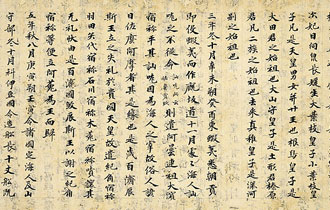Pages |
Even as Ondekoza members created new performance practices, they also worked to broaden the musical contexts in which taiko are used. Moving beyond the folk and theatrical elements that were the traditional realms of taiko, which guided the development of Ōsuwa Daiko and Sukeroku Taiko’s repertoire, Ondekoza members collaborated with composers of Western art music to create new compositions that utilizes taiko in different ways. At the center of this initiative was “Monochrome,” a piece written by Berlin-based composer Ishii Maki utilizing minimalistic and aleatoric music compositional techniques from Western art music. “Monochrome” helped pave the way for a new mode of taiko performance not reliant on festival or theatrical music, broadening the scope of contemporary taiko performance.
Kodō
By the late 1970s, a gap began to emerge between Den Tagayasu and the members of Ondekoza. To the members, Den appeared to be more interested in a series of documentaries about the group than about the original goal of revitalizing traditional arts and creating an artists’ university. Eventually, the members made the decision to part from Den. Following a confrontation, he left for Nagasaki and took the group’s drums with him, forming a new version of Ondekoza. The original members, meanwhile, remained on Sado, acquired new drums, and formed a new group called Kodō (combining characters for “children” and “drum,” in an effort to reflect the idea of the sound of the taiko being similar to the heartbeat within a mother’s womb, drawing upon stories they had heard of children falling asleep at Ondekoza concerts).
Kodō members continued many of the same practices they had previously pursued as Ondekoza: integrating regional performance styles into new and arranged pieces for concert performance, and working in collaboration with composers to create original taiko works. Among the regional styles they helped make famous as they toured around the world was one from the island of Miyake used during the Gozu Tennō Matsuri, rearranged in the piece “Miyake” (Figure 10).
Additionally, Kodō members were influential in helping make popular the use of katsugi okedō-daiko in contemporary taiko performance. Drawing upon performance techniques and basic carrying styles used in a festival drumming and dance from Iwate Prefecture called shishi odori (“Deer Dance,” named so because the drummers accompany dancers dressed like deer, or shishi), performers combined these elements with different playing techniques taken from Korean p’ungmul, a drumming genre that also uses carried drums. The result was a hybrid drumming style that allowed for a visually dynamic performance, often as players quickly play on both sides of the drum. This new performance style was utilized in a number of new compositions, including “Irodori,” composed in 1990 by Leonard Eto (Video 7).
Pages |











